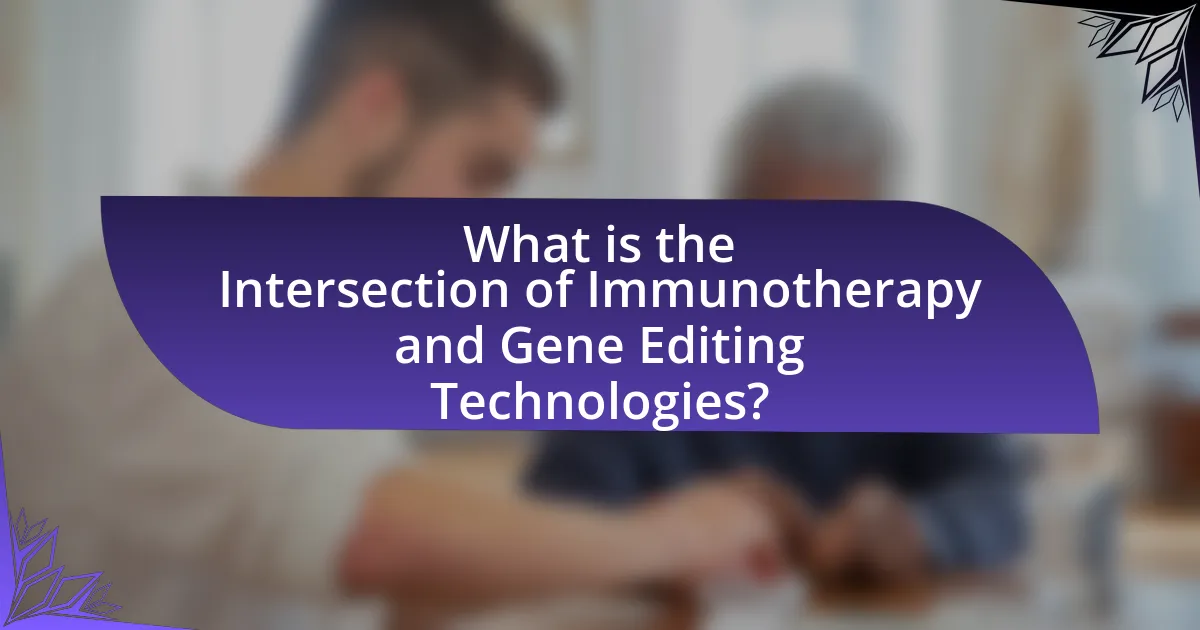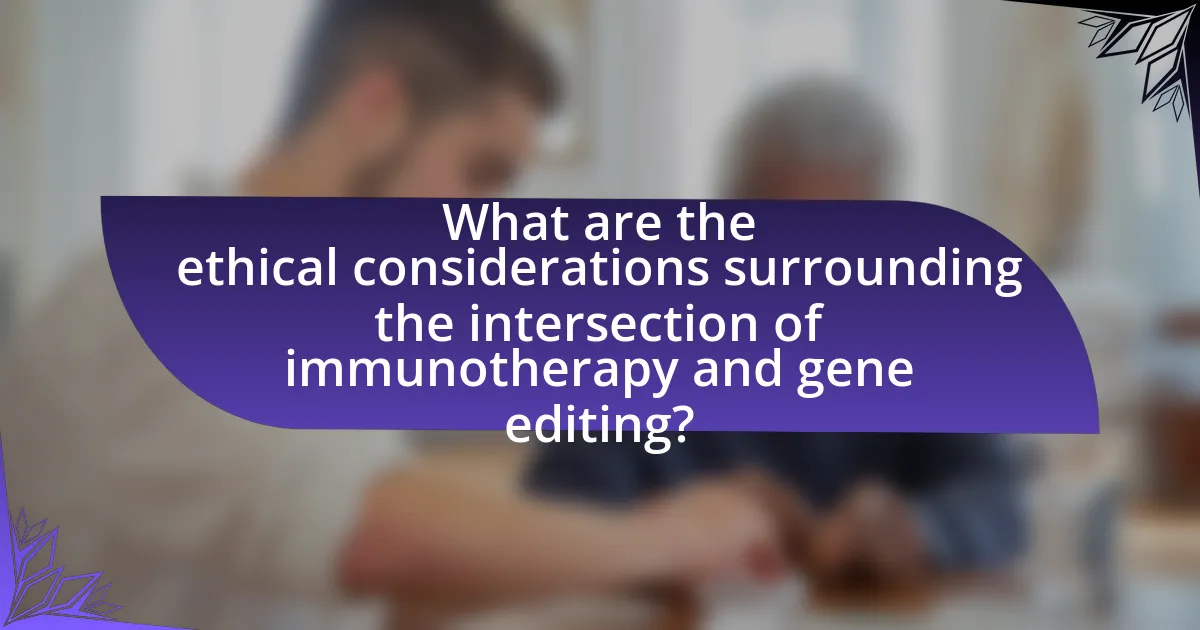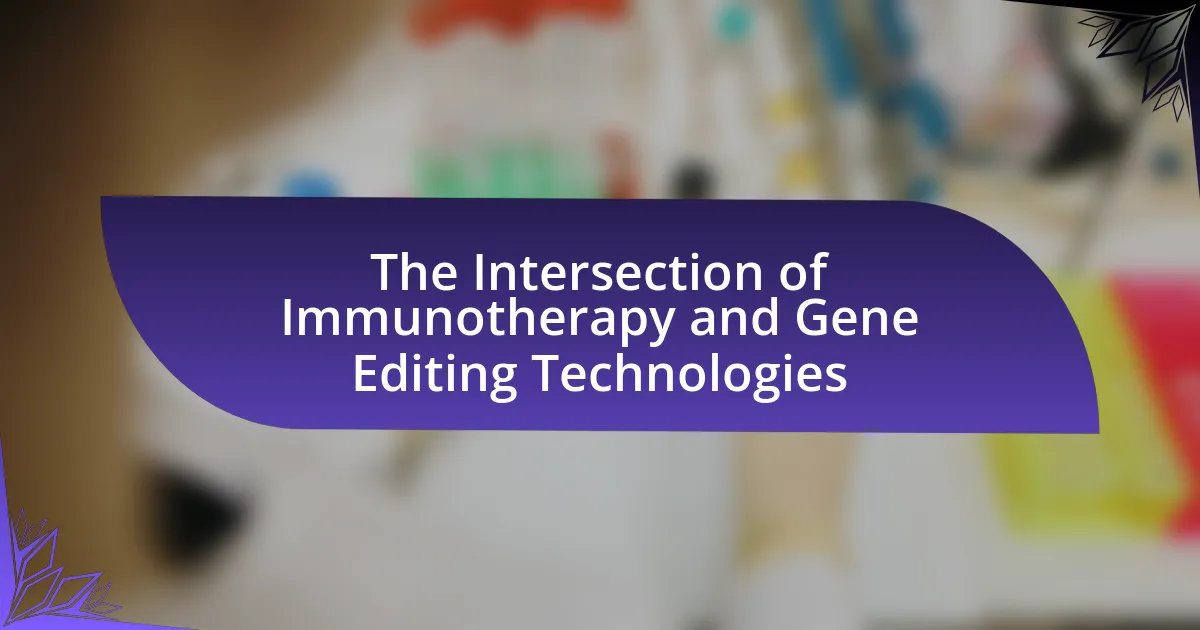The article focuses on the intersection of immunotherapy and gene editing technologies, highlighting their combined potential to enhance cancer treatment. It discusses how immunotherapy utilizes the immune system to target cancer cells, while gene editing technologies like CRISPR enable precise modifications of immune cells to improve their efficacy. Key concepts include the principles of immunotherapy, the mechanisms of gene editing, and the significance of their integration in modern medicine. The article also addresses advancements, current applications, ethical considerations, and future trends in these fields, emphasizing the transformative impact on personalized medicine and cancer therapies.

What is the Intersection of Immunotherapy and Gene Editing Technologies?
The intersection of immunotherapy and gene editing technologies lies in their combined potential to enhance cancer treatment by modifying immune cells to better recognize and attack tumors. Immunotherapy harnesses the body’s immune system to fight cancer, while gene editing technologies, such as CRISPR, allow for precise modifications of genes within immune cells. For instance, researchers have successfully used CRISPR to engineer T cells that express chimeric antigen receptors (CARs), improving their ability to target specific cancer cells. This synergy has been demonstrated in clinical trials, where genetically modified T cells have shown increased efficacy against various cancers, highlighting the transformative potential of integrating these two advanced therapeutic approaches.
How do immunotherapy and gene editing technologies relate to each other?
Immunotherapy and gene editing technologies are interconnected as both aim to enhance the body’s immune response against diseases, particularly cancer. Immunotherapy utilizes the immune system to target and destroy cancer cells, while gene editing technologies, such as CRISPR, can modify genes to improve immune cell functions or create personalized treatments. For instance, CAR-T cell therapy, a form of immunotherapy, involves editing T cells to express chimeric antigen receptors that specifically target cancer cells, demonstrating the practical application of gene editing in immunotherapy. This synergy between the two fields is evident in ongoing research and clinical trials that explore how gene editing can optimize immunotherapeutic strategies for better efficacy and safety.
What are the fundamental principles of immunotherapy?
The fundamental principles of immunotherapy involve harnessing the body’s immune system to recognize and attack cancer cells. This approach is based on the understanding that the immune system can be trained to identify specific antigens present on tumor cells, leading to targeted destruction. Key mechanisms include the use of monoclonal antibodies to enhance immune response, checkpoint inhibitors to remove regulatory brakes on immune cells, and adoptive cell transfer to infuse activated immune cells into patients. Clinical evidence supports the efficacy of these strategies, as seen in the success of therapies like pembrolizumab and CAR T-cell therapy, which have significantly improved outcomes in various cancers.
What are the key concepts of gene editing technologies?
The key concepts of gene editing technologies include precision, efficiency, and versatility. Precision refers to the ability to make targeted modifications to specific DNA sequences, exemplified by technologies like CRISPR-Cas9, which allows for accurate cuts in the genome. Efficiency highlights the speed and effectiveness of these technologies in producing desired genetic changes, as seen in applications that can generate genetically modified organisms in a fraction of the time compared to traditional methods. Versatility indicates the broad range of applications, from agriculture to medicine, where gene editing can be utilized to enhance traits or correct genetic disorders. These concepts are supported by advancements in molecular biology and genetic engineering, which have demonstrated successful outcomes in various studies, such as the use of CRISPR in treating genetic diseases like sickle cell anemia.
Why is the intersection of these fields significant in modern medicine?
The intersection of immunotherapy and gene editing technologies is significant in modern medicine because it enhances the precision and effectiveness of cancer treatments. By combining immunotherapy, which harnesses the body’s immune system to fight cancer, with gene editing techniques like CRISPR, researchers can create personalized therapies that target specific genetic mutations in tumors. For instance, studies have shown that CRISPR can be used to modify immune cells, making them more effective at recognizing and attacking cancer cells, leading to improved patient outcomes. This integration not only increases the potential for successful treatments but also reduces side effects associated with traditional therapies, thereby revolutionizing cancer care.
What advancements have been made at this intersection?
Advancements at the intersection of immunotherapy and gene editing technologies include the development of CRISPR-based therapies that enhance immune responses against cancer. For instance, researchers have successfully utilized CRISPR to modify T cells, enabling them to better recognize and attack tumor cells. A notable example is the study published in 2020 by researchers at the University of California, which demonstrated that CRISPR-engineered T cells showed improved efficacy in targeting and eliminating cancer cells in preclinical models. This integration of gene editing with immunotherapy not only increases the precision of cancer treatments but also holds potential for personalized medicine approaches, as evidenced by ongoing clinical trials exploring these combined therapies.
How do these technologies complement each other in treating diseases?
Immunotherapy and gene editing technologies complement each other in treating diseases by enhancing the immune system’s ability to target and eliminate cancer cells while also correcting genetic mutations that contribute to disease progression. For instance, CRISPR gene editing can be used to modify immune cells, such as T-cells, to improve their recognition and attack on tumors, thereby increasing the efficacy of immunotherapy treatments. Studies have shown that combining these approaches can lead to more effective cancer treatments, as evidenced by research published in “Nature Biotechnology,” which demonstrated that engineered T-cells using CRISPR technology significantly improved anti-tumor responses in preclinical models. This synergy allows for a more personalized and effective treatment strategy, addressing both the immune response and the underlying genetic factors of diseases.

What are the current applications of combining immunotherapy and gene editing?
Current applications of combining immunotherapy and gene editing include enhancing the effectiveness of cancer treatments, developing personalized therapies, and improving the immune response against infectious diseases. For instance, CRISPR technology is utilized to modify T cells, enabling them to better target and destroy cancer cells. Research published in “Nature Biotechnology” by researchers from the University of Pennsylvania demonstrates that engineered T cells can be made more effective against tumors by editing genes that regulate their activity. Additionally, gene editing is being explored to create CAR-T cell therapies that are tailored to individual patients, increasing the likelihood of successful treatment outcomes.
How is this intersection being utilized in cancer treatment?
The intersection of immunotherapy and gene editing technologies is utilized in cancer treatment by enhancing the ability of the immune system to recognize and attack cancer cells. Techniques such as CRISPR-Cas9 are employed to modify immune cells, like T-cells, to improve their specificity and efficacy against tumors. For instance, researchers have successfully edited T-cells to express chimeric antigen receptors (CARs), which target specific cancer antigens, leading to more effective immune responses. Clinical trials have demonstrated that CAR T-cell therapies can lead to significant remission rates in certain blood cancers, showcasing the potential of this intersection in transforming cancer treatment paradigms.
What specific gene editing techniques are used in cancer immunotherapy?
CRISPR-Cas9 and TALENs are the specific gene editing techniques used in cancer immunotherapy. CRISPR-Cas9 allows for precise modifications of the genome, enabling the enhancement of T cells to better recognize and attack cancer cells. TALENs (Transcription Activator-Like Effector Nucleases) also facilitate targeted gene editing, which can be utilized to modify immune cells for improved anti-tumor responses. Both techniques have been validated in various studies, demonstrating their effectiveness in creating engineered T cells that can effectively target and eliminate cancer cells.
What are the outcomes of clinical trials involving these combined approaches?
Clinical trials involving the combined approaches of immunotherapy and gene editing technologies have shown promising outcomes, particularly in enhancing the efficacy of cancer treatments. For instance, studies have demonstrated that the integration of CRISPR gene editing with CAR-T cell therapy can lead to improved targeting of cancer cells, resulting in higher remission rates. A notable trial published in Nature in 2021 reported that patients with refractory cancers experienced a 50% response rate when treated with CRISPR-modified T cells, showcasing the potential of this combined strategy. Additionally, trials have indicated that gene editing can help overcome resistance mechanisms in tumors, further validating the effectiveness of these combined approaches in clinical settings.
What role does this intersection play in treating genetic disorders?
The intersection of immunotherapy and gene editing technologies plays a crucial role in treating genetic disorders by enabling targeted therapies that can correct genetic mutations and enhance the immune response against diseases. This combination allows for the precise editing of genes associated with genetic disorders, such as cystic fibrosis or sickle cell disease, while simultaneously utilizing immunotherapy to boost the body’s ability to fight these conditions. For instance, CRISPR-Cas9 gene editing has been successfully applied in clinical trials to modify genes in patients with genetic disorders, demonstrating significant therapeutic potential. Additionally, studies have shown that integrating immunotherapy can improve the efficacy of these gene-editing approaches by activating immune pathways that target and eliminate diseased cells.
How can gene editing enhance the effectiveness of immunotherapy for genetic diseases?
Gene editing can enhance the effectiveness of immunotherapy for genetic diseases by enabling precise modifications to immune cells, allowing them to better recognize and attack diseased cells. Techniques such as CRISPR-Cas9 facilitate the alteration of genes that encode for immune receptors, improving their specificity and efficacy against specific genetic mutations associated with diseases. For instance, research has shown that editing T cells to express chimeric antigen receptors (CARs) significantly increases their ability to target cancer cells, leading to improved patient outcomes in therapies for certain genetic cancers. This targeted approach not only boosts the immune response but also minimizes off-target effects, making immunotherapy more effective and safer for patients with genetic diseases.
What challenges are faced in applying these technologies to genetic disorders?
The challenges faced in applying immunotherapy and gene editing technologies to genetic disorders include ethical concerns, technical limitations, and regulatory hurdles. Ethical concerns arise from the potential for unintended consequences, such as off-target effects in gene editing, which can lead to new health issues. Technical limitations involve the difficulty in delivering gene therapies effectively to target cells and ensuring long-term expression of the edited genes. Regulatory hurdles stem from the need for extensive clinical trials to demonstrate safety and efficacy, which can delay the availability of these treatments. For instance, the U.S. Food and Drug Administration (FDA) requires rigorous testing protocols that can take years to complete, impacting the speed at which innovative therapies reach patients.

What are the ethical considerations surrounding the intersection of immunotherapy and gene editing?
The ethical considerations surrounding the intersection of immunotherapy and gene editing include concerns about safety, consent, equity, and the potential for unintended consequences. Safety issues arise from the risks associated with gene editing techniques, such as CRISPR, which may lead to off-target effects or unforeseen health complications. Consent is critical, particularly in clinical trials, where patients must fully understand the implications of altering their genetic makeup. Equity concerns highlight the potential for disparities in access to these advanced therapies, which may exacerbate existing healthcare inequalities. Additionally, the possibility of creating “designer” genes raises moral questions about the extent to which humans should intervene in natural genetic processes, potentially leading to ethical dilemmas regarding the definition of normalcy and enhancement. These considerations are supported by ongoing debates in bioethics and regulatory discussions, emphasizing the need for comprehensive frameworks to guide the responsible use of these technologies.
What ethical dilemmas arise from gene editing in immunotherapy?
Gene editing in immunotherapy presents several ethical dilemmas, primarily concerning consent, equity, and potential misuse. The issue of informed consent arises as patients may not fully understand the implications of gene editing, particularly in terms of long-term effects and genetic modifications that could be passed to future generations. Equity concerns highlight the risk of exacerbating health disparities, as access to advanced gene editing therapies may be limited to affluent populations, leaving marginalized groups without treatment options. Additionally, the potential for misuse of gene editing technologies raises fears about “designer” therapies that prioritize enhancement over therapeutic necessity, leading to ethical questions about the nature of human enhancement and the definition of normalcy in health. These dilemmas necessitate careful consideration and regulation to ensure ethical practices in the application of gene editing in immunotherapy.
How do regulations impact the development of these technologies?
Regulations significantly impact the development of immunotherapy and gene editing technologies by establishing safety, efficacy, and ethical standards that must be met before these innovations can be widely adopted. For instance, the U.S. Food and Drug Administration (FDA) requires rigorous clinical trials to assess the safety and effectiveness of new therapies, which can prolong the development timeline but ensures patient safety. Additionally, regulations such as the European Union’s General Data Protection Regulation (GDPR) influence how genetic data is handled, affecting research methodologies and data sharing practices. These regulatory frameworks are essential for maintaining public trust and ensuring that advancements in these technologies are both safe and ethically sound.
What are the public perceptions of gene editing in medical treatments?
Public perceptions of gene editing in medical treatments are generally mixed, with significant concern about ethical implications and potential risks. A 2021 survey by the Pew Research Center found that 72% of Americans believe gene editing could lead to unintended consequences, while 60% expressed support for its use in treating serious diseases. This indicates a cautious optimism, as many recognize the potential benefits of gene editing for conditions like genetic disorders and cancer, yet remain wary of the ethical dilemmas it poses, such as designer babies and genetic inequality.
What best practices should be followed in research and application?
Best practices in research and application within the intersection of immunotherapy and gene editing technologies include rigorous ethical oversight, comprehensive preclinical testing, and transparent reporting of results. Ethical oversight ensures that research adheres to established guidelines, such as those set by the National Institutes of Health, which mandate the consideration of potential risks and benefits to patients. Comprehensive preclinical testing, including in vitro and in vivo studies, is essential to assess the safety and efficacy of new therapies before human trials. Transparent reporting, as emphasized by the CONSORT guidelines, facilitates reproducibility and trust in research findings, allowing for informed decision-making in clinical applications.
How can researchers ensure ethical compliance in their studies?
Researchers can ensure ethical compliance in their studies by adhering to established ethical guidelines and obtaining informed consent from participants. Ethical guidelines, such as those set forth by the Declaration of Helsinki and the Belmont Report, provide a framework for conducting research responsibly, emphasizing respect for persons, beneficence, and justice. Informed consent involves clearly communicating the purpose, risks, and benefits of the study to participants, allowing them to make an educated decision about their involvement. Additionally, researchers should undergo institutional review board (IRB) approval to evaluate the ethical aspects of their research proposals, ensuring that the rights and welfare of participants are protected throughout the study.
What guidelines exist for the responsible use of these technologies?
Guidelines for the responsible use of immunotherapy and gene editing technologies include adherence to ethical standards, regulatory compliance, and prioritization of patient safety. Ethical standards emphasize informed consent, transparency in research, and equitable access to treatments. Regulatory compliance involves following established protocols set by organizations such as the FDA and EMA, which ensure that therapies undergo rigorous testing for safety and efficacy. Prioritizing patient safety requires continuous monitoring of treatment outcomes and potential side effects, as highlighted by the National Institutes of Health, which stresses the importance of long-term studies to assess the impact of these technologies on human health.
What future trends can we expect in the intersection of immunotherapy and gene editing?
Future trends in the intersection of immunotherapy and gene editing include the development of more personalized cancer treatments and enhanced immune responses through CRISPR technology. Researchers are increasingly focusing on using gene editing to modify immune cells, such as T-cells, to better target and destroy cancer cells. For instance, studies have shown that CRISPR can be used to knock out genes that inhibit T-cell function, thereby improving their efficacy in immunotherapy. Additionally, the combination of CAR-T cell therapy with gene editing is expected to lead to more effective treatments for various cancers, as evidenced by ongoing clinical trials demonstrating improved patient outcomes.
How might advancements in technology influence future treatments?
Advancements in technology will significantly influence future treatments by enhancing the precision and effectiveness of immunotherapy and gene editing. For instance, the development of CRISPR-Cas9 technology allows for targeted gene modifications, which can improve the efficacy of immunotherapies by enabling the immune system to better recognize and attack cancer cells. Research published in “Nature Biotechnology” by Doudna and Charpentier highlights that CRISPR can be used to edit immune cells, making them more potent against tumors. Additionally, artificial intelligence is being utilized to analyze vast datasets, leading to the identification of new biomarkers for personalized treatment plans. This integration of advanced technologies is expected to revolutionize treatment protocols, making them more tailored and effective for individual patients.
What potential breakthroughs are on the horizon for these fields?
Potential breakthroughs on the horizon for the intersection of immunotherapy and gene editing technologies include the development of personalized cancer treatments that utilize CRISPR gene editing to enhance immune responses. Research indicates that combining CRISPR with immune checkpoint inhibitors can lead to more effective targeting of cancer cells while minimizing damage to healthy tissues. For instance, a study published in Nature by researchers from the University of California demonstrated that CRISPR-engineered T cells could significantly improve tumor regression in mouse models. This approach not only aims to increase the efficacy of existing immunotherapies but also holds promise for treating a wider range of cancers by tailoring therapies to individual genetic profiles.



